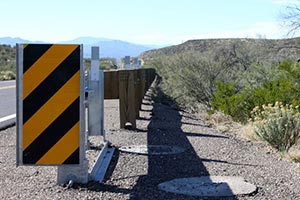Guardrail Review Revamped by Federal Highway Administration

The Federal Highway Administration tightened its review process for highway guardrails and other roadside devices, making the first major changes since questions about the safety of a Trinity Industries Inc. system emerged in 2012.
Starting next year, manufacturers planning to make even minor revisions to highway products will have to test them to the latest, most stringent safety criteria, the agency said in a statement May 18.
FHWA also will require manufacturers and crash-test laboratories to disclose any mutual financial interests, according to the agency.
The announcement effectively eliminates a loophole that has allowed manufacturers to avoid full-scale crash testing by incrementally revising existing products.
It also means that companies no longer will be able to have their devices crash-tested at a facility with an undisclosed financial stake in the product’s commercial success. Trinity’s ET-Plus guardrail system was first tested by a lab that stood to make royalties from its sales should FHWA sign off on its safety.
“It’s what they should be doing,” said Sean Kane, president of Safety Research & Strategies Inc., a product-hazard research group based in Rehoboth, Massachusetts. “It’s unlikely to have happened but for the ET-Plus controversy.”
The push toward updated safety criteria “is simply part of the normal process,” FHWA spokesman Neil Gaffney said in an e-mail.
A Texas jury in October found that Trinity had committed fraud by failing to inform the federal government of ET-Plus changes made in 2005. One day after the verdict, FHWA required Trinity to submit a plan for fresh crash tests of the revised ET-Plus, based on guidelines in place since 1993.
Critics of the ET-Plus, including Kane and U.S. lawmakers, say that the cost-saving design changes made the Trinity device potentially lethal. They have called for FHWA to require crash tests of the modified version under the updated safety criteria, which were instituted in 2011, and account for a wider variety of real-world crash conditions involving heavier vehicles.
Testing under the latest guidelines is necessary to “ensure the device is safe enough for today’s roads,” U.S. Sen. Richard Blumenthal (D-Conn.) said in a November letter to FHWA acting Administrator Gregory Nadeau. “I am very concerned that the testing protocol you’ve prescribed is woefully inadequate and far too deferential to Trinity.”
FHWA said in March that the ET-Plus had passed all eight of the recently mandated tests. Trinity has said testing under the older criteria was appropriate because the ET-Plus was designed and tested to those standards.
FHWA’s sign-off on a new device, which is based on crash test reports and other data, is required for states to receive federal taxpayer reimbursement to buy highway equipment. Certification of the ET-Plus system has opened up hundreds of millions of dollars in sales for Trinity.
The ET-Plus initially was crash-tested by the Texas A&M Transportation Institute in College Station, where researchers helped invent the system and have made millions in royalties from its sales. FHWA’s request for a crash test plan after the Texas jury verdict required Trinity’s chosen testing facility to disclose any financial interest in roadside safety devices.
FHWA, along with an association of state transportation officials, is examining crash data to determine whether further testing of the modified ET-Plus is needed.
“Our goal is to make our roads, bridges and highways as safe as possible, in part by accelerating the move to the newer crash test criteria,” Nadeau said in a statement.

